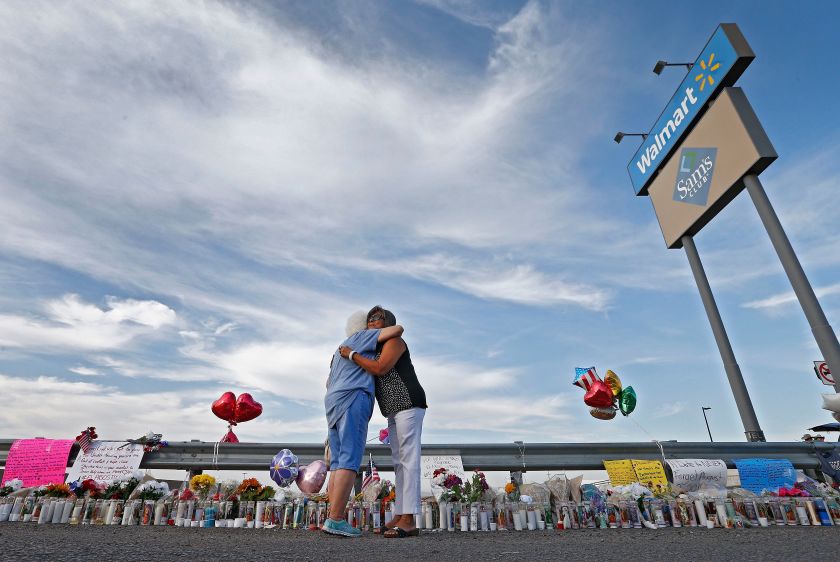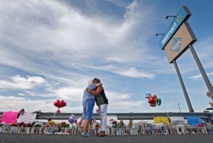The first verses recounted the ghastly, heartbreaking events from days before. "At Walmart by Cielo Vista / People walked peacefully / But they never imagined / Their lives would be changed."
But by the end, the song was a statement of resilience and resistance.
"It was a terrorist act that this monster perpetuated," Rodriguez sang in Spanish. He wore casual clothes while his bandmate, dressed in a full black mariachi suit, accompanied him on guitarron. "He was trying to break our people, but failing to do that, we're actually more united than ever before."
A USA Today photographer, J. Omar Ornelas, captured their impromptu performance and shared it widely on social media.
The young musicians' instinct to document the tragedy in song fits into a centuries-old tradition of Mexican and Chicano songwriting. The corrido, a form of folk ballad, is a first draft of history. It praises heroes, names villains and makes a ledger of valor and loss.
In times of tragedy, it's often the first place the affected turn.
"It's a cultural need that happens right away," said Steve Loza, a professor of ethnomusicology at UCLA and a composer of politically salient Latin orchestral music. "It's a way of paying tribute and honor and respect to people, be they a political hero, a baseball player or people who have been killed through a politically related hate crime. The people who died are considered to be heroes. The corrido is a form of acknowledging the people who died for their cause and their culture."
The corrido, as a narrative story-song, stretches back to the mid 19th century. Early examples extolled the rebellions of Pancho Villa and Benito Juarez. They were written quickly by professionals or amateurs, adapted locally in the heat of big events. Songwriters used them to remember history, satirize politicians or just serve as a gripping campfire tale.
In past decades, the rise of narcocorridos _ songs about the outlaw violence of the drug trade _ gave a dark twist to the form. Bands like Los Tigres del Norte used the style to revel in, critique and mock cartel culture, in much the way gangsta rappers grappled with the allure and peril of their trade.
The 2014 killings of 43 students in the Mexican state of Guerrero, however, underlined the genre's potency as a way to protest the unthinkable in the social media era. Hundreds of songs, like "Ayotzinapa 43" from Chicago'sJose Luis Carrisoza Jr. and his father, Jose Luis Carrisoza Sr., flooded YouTube as impromptu memorials and calls to action.
The El Paso massacre likely will be a similar historic tragedy for Mexican and Chicano songwriters to document.
The accused El Paso gunman, Patrick Crusius, confessed to the killing and said he intended to target Mexicans. Eight of the 22 victims were Mexican nationals, and many of the dead had Latino surnames. Authorities said he posted a racist screed shortly before the attacks that echoed President Trump's rhetoric about an invasion of Latinos over the U.S. border.
Sadly, the El Paso shooting evoked many of the themes of corridos _ tragedy, heroism, national identity and conflict at the U.S.-Mexico border. It's no surprise that, in the wake of such loss and racial strife, songwriters are already turning to the form to make sense of it, and name who they think is to blame for it.
"This has been a way for Mexican people to react to Trump over the last few years, and all his obnoxious, insulting, hateful rhetoric. It's a way to put that whole thing into perspective," Loza said. "I wouldn't be surprised to see Trump's name or the name of the [alleged] killer come up" in future corridos.
Border towns like El Paso (next door to Ciudad Juarez, Mexico) play a huge role in corrido tradition. Texas border culture has inspired some of the best-known corridos, such as songs about Juan Nepomuceno Cortina (who shot a U.S. marshal for abusing a servant) and Gregorio Cortez (who killed a U.S. sheriff after an unjust arrest).
For years, groups of son jarrocho musicians have gathered at the Tijuana border wall to perform together from opposite sides. In 2018, Grammy-winning Latin jazz composer Arturo O'Farrill brought a cross-cultural orchestra to the border to record an album, "Fandango at the Wall."
In Puerto Rico, reggaeton and Latin trap artists like Bad Bunny, iLe and Residente were at the front lines of protests against the U.S. territory's governor, Ricardo A. Rossello, leading to his resignation.
Latin America has a 500-year-old history of using music to document and resist racist oppression and violence. After the tragedy at El Paso, expect to see much more of it.
"When something like this happens, people won't forget about it, they will make it part of their culture," Loza said. "All of this stuff around the wall, immigration and the massacre is instigating major musical expression. This music will pay homage to heroes and it will name villains."
---------------------------------------------------------------------------------------------------------------------------









 Home
Home Politics
Politics











